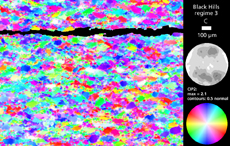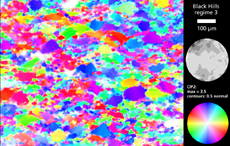4.5
ORIENTATION IMAGES OF EXPERIMENTALLY DEFORMED ROCKS
top / contents / section 4 / pages -- 4.1 -- 4.2 -- 4.3 -- 4.4 -- 4.5 -- 4.6 -- 4.7
More detail on regime 3 of the dynamic recrystallization

Experimentally deformed Black Hills quartzite, sample CQ78, site C (see previous page 4.2). Deformation occurred in the transition region between regime 2 and regime 3 dislocation creep (Hirth & Tullis, 1992).
Experimental conditions:
- pc = 1.5 GPa,
- T = 900°C,
- strain rate = 10-6s-1,
- total shortening: 36%.
The input images have been captured using three Zeiss Epiplan Pole microscope objectives of in creasing magnifying power and numerical aperture: 2.5x/0.075, 5x/0.15 and 10x/0.30. The spatial resolution of optical orientation imaging and the depth of the analyzed volume depends on the numerical aperture, and is as good as the optical resolution of the microscope.
As the image area gets smaller, the statistics of the pole figure deteriorates; the texture index increases as single crystal measurements are approximated.
Left, from top to bottom:
- CQ78, site C, using 2.5x objective
- CQ78, site C, using 5x objective
- CQ78, site C, using 10x objective

